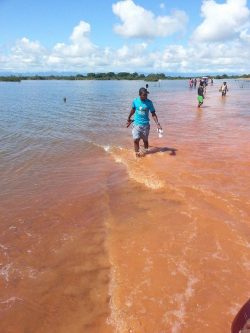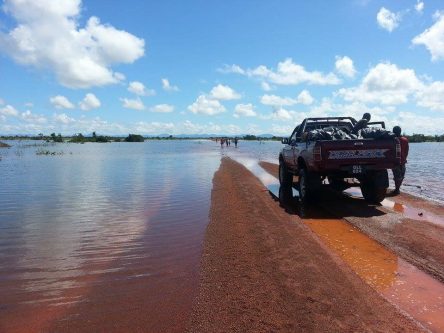The current flooding in the Rupununi is under control says Regional Chairman Bryan Allicock though many farms remain under water.
He was at the time offering an update on the recent flash floods that have hit Region Nine (Upper Takutu/Upper Essequibo) after several days of heavy rainfall and the cresting of rivers in the region, leaving farms inundated.
“We have the relevant stakeholders on board…the Region is also trying to access some of the resources to cover the expenses that accompany the provision of food for those in the shelters and then we have the military and the Community Police Group [CPG] operating to assist in the transportation of persons between St. Ignatius and Lethem on a daily basis,” he shared.

“So far we have 39 persons in shelters including children, and we have others who had to be evacuated from their premises and have moved to other relatives in the Lethem Township. In St. Ignatius we have four households who relocated themselves to their relatives across the border in Bom Fim [Brazil],” the Chairman added.
Other reports as of yesterday morning said that the main road at Tabatinga Bridge entrance (Northern end) to the commercial area, and the Takutu Drive between Lethem Power Company and the Magistrate’s Court were covered by the floodwaters.
Floodwaters were also reportedly spreading towards the southern end (Airport end) of the Lethem airstrip. However, there is no threat to aircraft landing or taking off.
In St. Ignatius Village, the approaches on both sides, as well as, the main road of the second entrance behind the St Ignatius Secondary School had been inundated, preventing small vehicles from entering or leaving the village.
As it relates to communities in the other sub-districts, Allicock said the Regional Administration has not received any reports that would indicate that there was a need for evacuation of homes. They have, however, received countless reports of farms being inundated.
The Chairman indicated that this would be of particular concern to the farmers since the cassava plant does not take long to rot when threatened by flooding.
“We are getting reports that most of the farms in these villages are under water, and as you may know cassava don’t take too long to rot; three days and it’s already gone to the other side,” Allicock added.

In terms of the need for food and other supplies, the Chairman said the RDC has been in contact with officers from the different sub-districts who continue to supply updates on the situation in those areas, including the need for the relevant supplies.
At present, Allicock said they have not yet received any request for relief since it is mostly farms which are affected and not residents.
“We know that later this month we will have to bring in relief supplies to distribute to the villages, so we have our officers within the sub-districts keeping us updated on what is happening but so far we have not had anyone requesting any relief as yet, because they are still on what they salvage from the rotten cassava,” he said.
Notwithstanding, it is his belief that the current situation with the farmland has the potential to create a short term-dependency on alternative sources of food which will have to be provided by the Region.
“I know we will come to that time where we will need to issue ration and to those villages in need. We haven’t started with that as yet but we predict that we will have to at some point of time,” Allicock continued.
Mike Williams, a North Rupununi resident and member of the North Rupununi District Development Board spoke to Stabroek News, and shared similar concerns, saying that although efforts are being made to harvest as much cassava as they possibly can at the moment, they predict that there will be a need for food relief in the weeks to come.
“We are trying to save the crops as much as possible… At the moment we are saying that the people are okay in terms of ration for now, but the farms are in danger and we foresee that if the situation continues like this, by next month those that have been reaped will be finished,” Williams said
Meanwhile, Allicock said that though the water has started to recede on the outskirts of Lethem, the rains in neighbouring Brazil continue. This could have serious implications on the current situation in the Rupununi, since it is the backing up of the rivers on that side of the border into the Takutu and Ireng Rivers which has caused the floods.
In terms of the health implications of the flood, Allicock said the Civil Defence Commission (CDC) on Monday handed over sanitary supplies which will be distributed to those in need.
In addition to this, a health team from Lethem was last evening dispatched to the North Rupununi to gather data and assess the situation in that area. There are also three teams doing data collection in Lethem. The Regional Administration also has the support of extension officers, community development officers and district development officers who are assisting with the provision of data from the other sub-districts.
Meanwhile, the Guyana Water Incorporated (GWI) in a statement issued yesterday afternoon said that one of its four operating pump stations in Lethem is currently affected by the floodwaters.
“This is the Old Culvert City Pump Station where water can be seen in the compound surrounding the well. However, upon physical inspection, the well has not been compromised to date, and we are monitoring accordingly. All other pump stations are fully operable,” the statement read.
In the meantime, GWI has mobilized efforts to provide potable water to affected residents and the general public in the South Rupununi and other parts of Region Nine, which include the setting up of water distribution access points at the Tabatinga Pump Station and the New Culvert City Pump station.
Additionally, GWI said that it will be monitoring the quality of water distributed to residents by performing tests at each pump station, as well as, at strategic points in the distribution network. The testing of private wells will also be facilitated upon request.
“As the national water utility company, GWI will be assisting in the data collection to build a database for the affected areas, as well as assisting the RDC/CDC/NDC in supplying the necessary pipe fittings required for the distribution of potable water,” the statement said.
“Moreover, GWI will be distributing Life Saver filters and Jerry Cans to the Region, so as to ensure adequate mechanisms are in place to treat water and maintain access to quality water for affected residents. GWI’s efforts complement those of the Mayor and Town Council, the Community Policing Group, the Guyana Defence Force and other Regional agencies. As GWI continues to monitor the situation, we are committed to providing the necessary assistance to ensure relief for affected communities,” GWI said.





